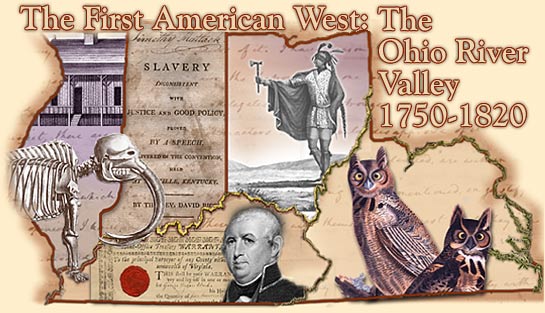Digital Archaeology: the Original First American West
The original First American West (FAW) project site consisted of 15,000 pages of original historical material drawn from the collections of the Filson Historical Society and the University of Chicago. While it was an early standard bearer for digital history, it has been unavailable since 2016.
The FAW showed archivists, scholars, and educators what was possible in the new digital media available in the early 2000s, but twenty years after its launch, the project reminds us to plan as carefully for digital sustainability as we do for the long-term stewardship of the physical letters, maps, and objects featured in the exhibit.
A rendering of the original FAW site is available on the archive.org Wayback Machine
There, readers can still get a good sense of the intellectual foundations of the project in the collections of Reuben Durrett, the Filson's founder, which are split between the Filson and the University of Chigago.
Building the Digital Collection
Because FAW was a pioneer digital project, it was as important to share the digization process and technical specifications as it was the 18th and 19th century historical content. FAW was envisioned by its funders and its cooperating institutions as a blueprint for future digital humanists.
Digitization: Creating Images
Flatbed scanners, overhead imaging, Photoshop, and TIFF files were and remain the industry standards. FAW listed hardware, file types, and resolutions that are still common today, for both professional and personal digitization projects.
At Chicago, all manuscripts and broadsides were scanned on the Epson Expression 1640XL flatbed scanners in 24-bit color using Lasersoft Silverfast 5. Broadsides were scanned at 400 dpi and manuscripts were scanned at 600 dpi in order to capture the detail and characteristics of the ink, the handwriting, and the texture of the paper. Images were saved as uncompressed TIFF files and edited in Adobe Photoshop 5.5. A slight border was left around all manuscript and broadside scans so that the whole artifact can be viewed.
At the Filson Historical Society, all manuscripts and broadsides were scanned on an Epson Expression 836XL flatbed scanner in 24-bit color 300 dpi and saved as uncompressed TIFF files.
All prints were scanned in 24-bit color at 600 dpi in order to capture fine line detail in the originals, and the transparencies of prints were scanned in color at 1200 dpi using an Epson Expression 1640XL flatbed scanner with a transparency adapter. Images were saved as uncompressed TIFF files and edited in Adobe Photoshop 5.5.
Digitization: Transcription
Any usable transcription is more than words on the page. Good transcriptions account for irregularities of spelling, corrections, archaic usage, and layout on the page. Transcribers and editors must take care to balance understanding of the text as well as visual representation of the physical page. Adding the layer of digitial full-text searchability creates an additional layer of care for editors.
The original FAW project transcribed 225 pages (31 printed books and articles and 74 manuscript items) using an outside vendor, Pacific Data. An additional 74 manuscript items were transcribed by UC and Filson staff.
Editing principles for transcription of manuscripts in the original FAW:
- Original capitalization, punctuation, spelling, slips of the pen, and syntax are preserved.
- Abbreviations, contractions, and ampersands (& and &c.;) are retained as written.
- Proper names, signatures and marks, and numbers are maintained.
- Long s is transcribed as short s.
- U and v are transcribed according to appropriate usage.
- Tailed p is extended to per, pro, or pre depending on the text.
- Thorns (ye yt ym) are transcribed the, that, or them.
- Catch words are omitted.
- Interlineations are included in the body of text at the point specified by the manuscript's writer.
- Super and subscripts have been lowered or raised to the text line.
- The number of multiple signatures [56 names] and the presence of seals [seal] have been indicated within brackets.
- The appearance of words struck through is retained or is indicated by brackets [one word struck through].
- Illegible text is identified by brackets [three words illegible].
- Interpolation of missing or damaged text is followed by a ? mark; if an interpolation is not supplied the appearance of the original is indicated in brackets [words missing]
Intellectual Access to the Collection
The subject tags that provided an additional layer of discoverability to the original FAW site were developed by Filson and UC staff and recorded in Dublin Core metadata standard, the same standard upon which this Omeka site is built.
The project published extensive Dublin Core metadata guidelines, showing criteria for assigning authorship, date, source, content type, and subject. For anyone seeking to understand the original production of FAW or to create metadata standards for a smiliar digital humanities project, the FAW guidelines are as valuable now as they were in the early 2000s.
Technical Standards for Personal Digitization Projects
The technical standards used and published by the orignial FAW project are largely still sound digitial humanities practice today. Watch Filson Digital Initiatives & Preservation Archivist present on how these principles can improve personal and family history digitization projects in this recording of a lecture to the Filson membership in the summer of 2022.

